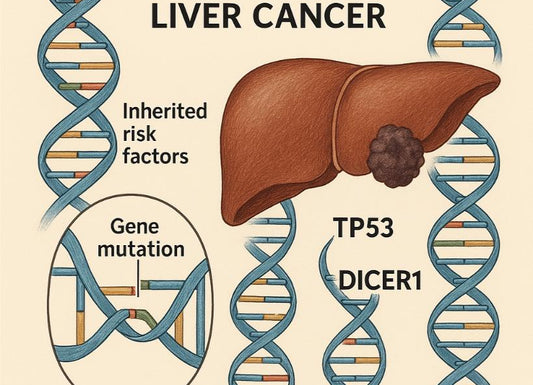Should I Worry About a Liver Ultrasound? What Your Results Might Mean
 Written By
Abel Tamirat, MD
Written By
Abel Tamirat, MD

A liver ultrasound is a common imaging test used to check the health of your liver. If your doctor has ordered one, it’s natural to wonder, “Should I worry about a liver ultrasound?” The answer is usually no – the ultrasound itself is painless and non-invasive, and many people have them without any serious problem. It helps your doctor get a clearer picture of your liver (literally) to confirm or rule out concerns raised by symptoms or blood tests. In fact, experts note that ultrasound is often the first test when there’s suspicion of liver disease.
What Is a Liver Ultrasound and Why Is It Done?
A liver ultrasound (also called an abdominal ultrasound of the liver) is an imaging procedure that uses high-frequency sound waves to produce pictures of your liver and surrounding area in real-time. Unlike X-rays or CT scans, ultrasound uses no radiation, making it a very safe test. During the exam, a technician (sonographer) moves a handheld probe (transducer) across your upper abdomen. A cool gel on your skin helps the sound waves travel. The ultrasound machine then translates the echoes into images on a screen.
Doctors rely on liver ultrasounds for several reasons. Common triggers include:
-
Abnormal liver blood tests: Elevated liver enzymes (ALT, AST, ALP, etc.) often prompt an ultrasound to see if there’s an underlying cause.
-
Symptoms of liver disease: Jaundice (yellow skin/eyes), unexplained upper right abdominal pain, or fatigue can signal a problem. An ultrasound helps identify issues like gallstones or liver inflammation.
-
Routine monitoring: If you already have a known liver condition (fatty liver, hepatitis, cirrhosis, etc.), your doctor may use periodic ultrasounds to track disease progression or treatment response.
-
Screening: In people at high risk for liver cancer (for example, those with cirrhosis or chronic hepatitis B/C), ultrasound can be part of a routine screening program for early tumor detection.
What to Ask Your Doctor Before a Liver Ultrasound
Before any medical test, it’s good to be prepared and informed. If your doctor has recommended a liver ultrasound, here are some useful questions to discuss beforehand:
-
Why is this test being done? Make sure you understand what your doctor suspects. For example, do they think you might have fatty liver, gallstones, a cyst, or something else? Knowing the reason can help relieve anxiety.
-
What will the doctor look for? You can ask what specific findings the doctor is checking for example, gallstones, liver fat, masses, or bile duct blockages. This can give you a picture of what symptoms or test results prompted the scan. For instance, if you had elevated liver enzymes, the doctor might be looking for fatty liver or fibrosis. If you’ve had jaundice, they might be checking bile ducts or gallbladder.
-
What will it involve and how do I prepare? Ask about fasting, medications, and clothing; most ultrasounds take 30 minutes and require 6–12 hours without food.
-
Who will perform and interpret the exam? Ultrasound scans are performed by a technician and read by a radiologist. Your doctor will typically explain the results during a follow-up.
Asking these questions ensures you’ll be fully informed and ready. A well-informed patient tends to feel less anxious and more in control.
Normal vs. Abnormal Liver Ultrasound Results
After a liver ultrasound, a radiologist carefully reviews the scanned images to assess whether everything appears within normal limits or if there are unusual findings. Understanding the difference between normal and abnormal results can help you better interpret your report and next steps.
What Does a Normal Liver Ultrasound Look Like?
A normal liver ultrasound shows a liver that is the expected size, shape, and texture. In technical terms, it appears as a smooth, uniformly gray organ with even echotexture, meaning there are no dark or bright patches indicating irregularities.
Here’s what radiologists look for in a typical scan summerized as a table:
|
Feature |
What It Means |
|
Even Texture |
The liver looks smooth and consistent—no strange spots or rough areas. |
|
No Lumps or Masses |
There are no cysts, growths, or unusual structures. |
|
Clear Blood Vessels |
The liver’s main veins (portal and hepatic) are open and the right size. |
|
Healthy Bile Ducts |
No swelling or blockage—bile can flow freely. |
|
Normal Gallbladder |
If visible, it appears healthy with no large stones or thick walls. |
|
Proper Size & Low Fat |
The liver is the right size for your body and has little fat (under 5% is ideal). |
If your report says “normal liver ultrasound” or “no focal lesions”, that generally means everything above is satisfied. However, keep in mind that mild liver dysfunction can sometimes exist even with a normal-appearing scan. In fact, some people with liver disease risk factors can still have a normal ultrasound. If you have other concerning symptoms or lab tests, your doctor may follow up with blood tests or other imaging even if the ultrasound is clean.
What Constitutes an Abnormal Liver Ultrasound?
If your ultrasound results are labeled abnormal, it means something looked different than expected. This doesn’t always mean something serious—many findings are harmless or easy to manage.
Here are some common reasons for an abnormal result:
- Liver size changes An enlarged or shrunken liver may signal inflammation, fat buildup, or scarring.
- Fatty liver (steatosis) Extra fat in the liver may appear bright on the scan, often linked to diet or lifestyle.
- Scarring or cirrhosis A bumpy liver texture can indicate long-term damage from hepatitis or alcohol use.
- Liver nodules or cysts These could be benign (like cysts or hemangiomas) or need further testing for cancer.
- Bile duct blockages or gallstones Enlarged ducts or stones may affect digestion or cause pain.
- Vascular changes The scan may show signs of slowed blood flow or pressure in liver veins.
The bottom line: Your doctor will explain what your result means and whether it needs follow-up. Many findings don’t require treatment, just monitoring and healthy changes.
When Should You Be Concerned?

It’s natural to feel anxious about abnormal results, but not every ultrasound “finding” is urgent. Here’s guidance on when concern is warranted and when it’s time to breathe easier:
-
The test is very safe – There’s no radiation, and it won’t cause harm. You won’t feel sick afterward.
-
The only risk is image clarity – If intestinal gas blocks the view, your doctor may recommend repeating the scan. The test itself carries no danger.
-
Watch for red flag symptoms – Call your doctor right away if you have severe abdominal pain, yellowing of your eyes or skin, confusion, or sudden weight loss—even before your results come back.
-
Lab results still matter – If your liver enzymes or bilirubin are very high, your doctor may order more tests, even if the ultrasound looks normal.
- Most findings are not serious – Things like fatty liver, cysts, or gallstones are common and often manageable. Your doctor will walk you through next steps based on your full picture.
Some people wonder, “Can liver function tests be normal with cirrhosis?” The answer is yes—which is why doctors may use multiple tests to form a full picture.
Treatment and Management Options

Treatment depends on what your ultrasound found. There’s no one-size-fits-all plan—but many liver conditions are manageable with the right steps.
-
Fatty liver (NAFLD/NASH) – Lifestyle changes are first. Losing even 5–10% of your weight can reduce fat and inflammation in your liver. Eat a balanced diet, get regular movement, and manage your blood sugar and cholesterol. Your doctor may also recommend vitamin E or monitor you with labs and follow-up scans.
-
Alcohol-related liver disease – If alcohol contributed to damage, quitting is essential. Support options include counseling, medication, and nutrition. Even with scarring, stopping alcohol can slow or reverse damage. Learn more about how drinking alcohol damages the liver and what steps to take to prevent further harm.
-
Hepatitis or autoimmune liver conditions – Treatments target the cause. Hepatitis C is often curable. Other types may need long-term medication or iron-reducing therapy.
-
Medication-related changes – Your doctor may stop or adjust medications that could be affecting your liver.
-
Gallstones or blockages – Procedures like ERCP or gallbladder surgery may be needed to restore bile flow and ease pressure on the liver.
-
Cirrhosis or tumors – Care often involves specialists. Some benign tumors are monitored, while others may need treatment.
- Follow-up matters – Even if no immediate treatment is needed, regular monitoring helps protect your liver over time.
Frequently Asked Questions
What does a liver ultrasound show?
It checks your liver’s size, shape, texture, and blood flow. It can also spot fat buildup, scarring, cysts, or blockages, and shows nearby structures like the gallbladder.
Do you need to fast before a liver ultrasound?
Usually, yes. Most providers ask you to fast for 6–12 hours to reduce gas and improve image quality. Follow your provider’s instructions.
Is a liver ultrasound safe?
Yes. It’s noninvasive, radiation-free, and even safe during pregnancy. There are no known medical risks.
Can a liver ultrasound miss anything?
Yes. It may miss very small liver lesions or early fibrosis. If needed, your doctor may order a FibroScan, CT, or MRI for more detail.
What if your liver ultrasound is abnormal, but you feel fine?
Some liver problems, like early fatty liver or small cysts, cause no symptoms. Your doctor may recommend lifestyle changes or monitoring.
Should you worry if your liver enzymes are high?
Not always. Mild elevation is common and not always serious. Your doctor will evaluate enzyme levels along with your liver scan.
What’s the difference between a liver ultrasound, FibroScan, and CT/MRI?
-
Liver ultrasound – First step, fast, noninvasive
-
FibroScan – Measures liver stiffness (for fibrosis)
- CT/MRI – Detailed imaging for tumors or complex issues
Final Thoughts
A liver ultrasound is a safe and straightforward way for your doctor to assess your liver health. In most cases, the results are either normal or show mild changes that can be managed with simple steps. If something unexpected does appear, it does not always mean a serious problem. What matters most is understanding your results in the context of your overall health. Stay informed, ask questions, and work with your doctor to decide what comes next.
In the meantime, you can stay proactive with Ribbon Checkup’s at-home liver health tests and easy-to-follow guides. These tools help you monitor your enzyme levels, understand your numbers, and support recovery between visits.
Written by Abel Tamirat, MD
Dr. Abel Tamirat is a licensed General Practitioner and ECFMG-certified international medical graduate with over three years of experience supporting U.S.-based telehealth and primary care practices. As a freelance medical writer and Virtual Clinical Support Specialist, he blends frontline clinical expertise with a passion for health technology and evidence-based content. He is also a contributor to Continuing Medical Education (CME) programs.
References
Askinazi, O. (2022, August 26). A Liver Ultrasound: What This Procedure Means. Retrieved April 30, 2025, from Healthline website: https://www.healthline.com/health/ultrasound-for-liver-disease
Clinic, C. (2023, August 25). A liver ultrasound is a simple and painless way to screen for liver diseases, including cirrhosis, fatty liver, cancer and other lesions. Retrieved April 30, 2025, from Cleveland Clinic website: https://my.clevelandclinic.org/health/diagnostics/liver-ultrasound
DO NOT WORRY WHEN ULTRASOUND RESULT IS FATTY LIVER. (2019). Retrieved April 30, 2025, from Victoriavn.com website: https://www.victoriavn.com/en/health-library/do-not-worry-when-ultrasound-result-is-fatty-liver
Liver Scan. (2024, April 15). Retrieved April 30, 2025, from Hopkinsmedicine.org website: https://www.hopkinsmedicine.org/health/treatment-tests-and-therapies/liver-scan
Silver, N. (2022, September 23). What to Know About Atypical Liver Ultrasound Results. Retrieved April 30, 2025, from Healthline website: https://www.healthline.com/health/abnormal-liver-ultrasound
Villines, Z. (2022, July 29). What to know about abnormal liver ultrasounds. Retrieved April 30, 2025, from Medicalnewstoday.com website: https://www.medicalnewstoday.com/articles/abnormal-liver-ultrasound
What to Know About Your Liver Ultrasound. (2019, November 6). Retrieved April 30, 2025, from Home website: https://www.docpanel.com/what-know-about-your-liver-ultrasound/

Dr. Abel Tamirat is a licensed General Practitioner and ECFMG-certified international medical graduate with over three years of experience supporting U.S.-based telehealth and primary care practices. As a freelance medical writer and Virtual Clinical Support Specialist, he blends frontline clinical expertise with a passion for health technology and evidence-based content. He is also a contributor to Continuing Medical Education (CME) programs.



